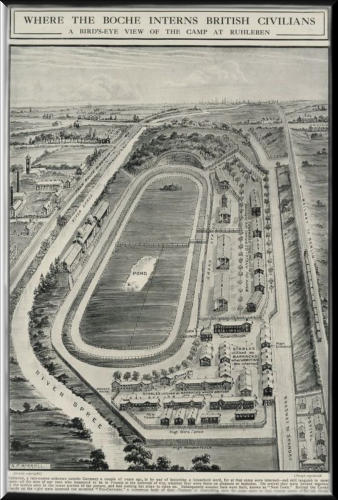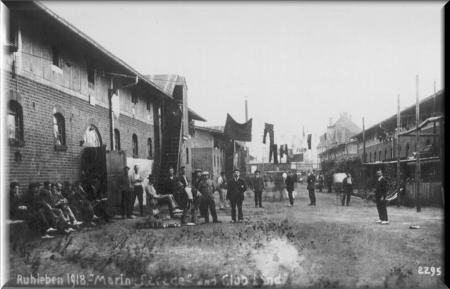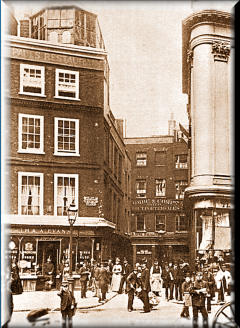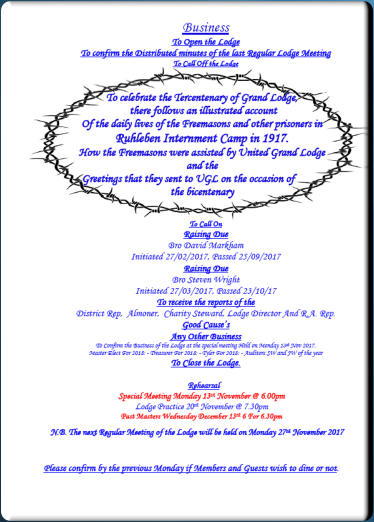


© Palatine Lodge - 1893 - 2023 - In se ipso totus teres -
2017 was the tercentenary of Grand Lodge and
we thought we would put on a special presentation to mark the
occasion. We decided it would be interesting to go back to the
bi-centenary, which wasn't celebrated very much in 1917 and
look at a particularly difficult time in the long history of
Freemasonry. The following narrative was mostly compiled by
W.Bro. Julian Fisher, who deserves more than a mention for this
first class and memorable evening. The addition of photographs
sourced from the internet and other resources added a visual
aspect which brought the history of Ruhleben Internment Camp
to life.
But let's start at the beginning: 300 years ago in 1717,
Masonic Lodges who were regulars at three London pubs met
with the members of a fourth Lodge who were the patrons of
yet another tavern, at the Goose and Gridiron Ale house in St
Paul's Churchyard and formed the very first Grand Lodge. They
elected the first Grand Master and arranged a party for the following year. This photo was taken in1890
During the next 100 years, a rival
Grand Lodge appeared in London which
claimed that the original Grand Lodge had
made innovations. So, for well over 60
years, the Ancients and the Moderns existed
side by side, neither recognising the other
as regular but by 1817, the process of
unification was well under way to form the United Grand Lodge of England. 1817 also marked the union of Royal Arch
Grand Chapters in England. 100 years after that, in 1917, Palatine Lodge was celebrating its 25th year and Bro Herbert
Bethel was Master of the Lodge. There was actually a muted celebration of the bi-centenary in the form of a special
meeting at the Albert Hall on Saturday 23rd June. Rather more importantly, the whole of Europe was caught up in
what we now call the Great War and it is in that year, the bi-centenary year, that we are going to concentrate on.
We are looking back in time and we are transporting ourselves to a different place, Ruhleben, which is less
than a mile from what was then the garrison town of Spandau to the west of Berlin. First, we need a little bit of
history. It all kicked off in June 1914 when Archduke Ferdinand was assassinated. Austria declared war on Serbia,
Russia mobilised in defence of Serbia, Germany declared war on Russia, Germany declared war on France then
Germany invaded Belgium which brought Britain into the war because we had agreed to defend Belgium. When war
broke out, there were over 10,000 British nationals, living, working or on holiday in Germany. Travel restrictions were
imposed on foreign nationals and the German authorities introduced powers to detain British and Commonwealth
citizens of military age - between the ages of 17 and 45.
On this side of the North Sea, Britain introduced similar restrictions, it is estimated, incidentally that there
were more than 25,000 German nationals over here and we also started taking some of them into detention.
Germany made representation to the British government that this practice wasn't acceptable and that Britain should follow the German example and simply restrict the movement of
foreign citizens and require them to report to the police on a regular basis. Germany then offered the opportunity of the repatriation of British subjects if this was matched by a similar
action from Britain. I don't know why, but Britain refused this offer which led to an ultimatum
from Germany, "Follow Germany's example by 5th November or all British nationals of military
age will be interned". And that, starting on 6th November 1914, is exactly what happened.
In the event, those interned were all males between the age of 17 and 55 and all officers of
whatever age whether on the active or retired list. the exceptions were: clergymen, doctors, bed
ridden invalids and lunatics. So, Ruhleben Concentration Camp came into being. It wasn't a
concentration camp with the terrible associations of the second World War but that is how it
was described at the time. It didn't contain any military personnel but the mass arrest of British
civilians in Germany started on Friday 6th November and, by late afternoon, hundreds of
bewildered men had already arrived at Ruhleben, a number that rapidly swelled to about 4000
and eventually peaked at between five and five and a half thousand. So, why Ruhleben? What
was in place there that was considered suitable for the long-term detention of thousands of
men?
The answer is that it was a race course for trotting horses and, apparently, it was a very popular venue for a family day out before the war. The advantage of using it as a detention
camp was that there was some 20 acres of securely fenced land with only one entrance gateway and it already had some substantial buildings in place. In the spectator area, there were
three grandstands, a restaurant known as the Tea House, a club house and casino, offices and toilets. Around the edge of the racecourse, there were eleven stables with hay lofts above,
some storage areas and basic accommodation for grooms and stable lads. So, this was going to be turned into a home for thousands of men and it wasn't an auspicious start. The plan was
for the men to live in the stable area while food would be provided from the grandstand area which would, eventually, be used for recreation. A field kitchen had been set up so the men
could be fed, the toilet facilities, designed for a Saturday afternoon race crowd were totally inadequate for 4000 men so military style latrines had been dug.
Tercentenary Celebrations 2017 focusing on 100 years ago, Ruhleben Internment Camp





















